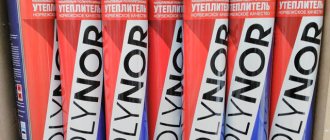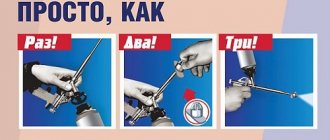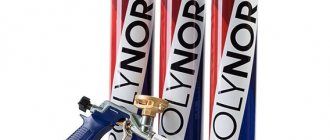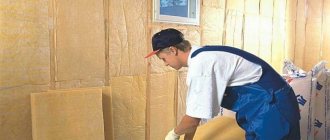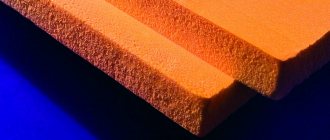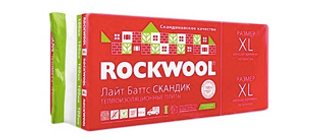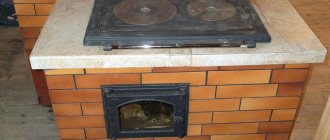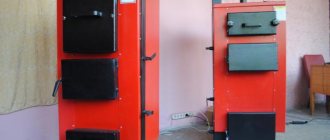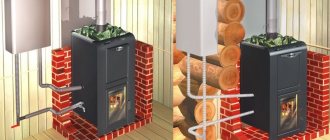Spray polyurethane foam Polynor
Single-component insulation Polinor is an innovation from Kazan. POLYNOR spray insulation is a type of foamed plastic that contains 90% air and 10% solids. This structure gives the material, in addition to thermal insulation qualities, also a large percentage of noise absorption. Unlike foam rubber, it is applied in a continuous layer without a single gap.
Characteristics of Polynor:
- Coating thickness 2.5-6 cm;
- Water absorption 2%;
- Density 18-28 kg/m3;
- Thermal conductivity 0.023-0.025 W/mK
- Service life about 35 years
- Setting speed at 20 °C – 40 minutes, complete drying – 3 days;
- Combustion: self-extinguishing substance.
Uniqueness of the material
- This is a one-component polyurethane foam insulation, unlike other sprayed polymer compounds. There are no analogues on the domestic market.
- Extreme ease of use - anyone can apply the composition; no special equipment is required.
- No electrical connection is required as no electric sprayers are used.
- Transporting and storing Polynor is extremely easy, because... it is packaged in small containers. This is much more convenient than transporting mineral wool or polystyrene boards.
- Packing small volumes allows you to do without leftover material. Exactly as much as required is used.
- During the foaming process, carbon dioxide is formed in the bubbles of the material. It has low thermal conductivity, which increases the thermal insulation characteristics of the insulation layer.
polynor.ru
Temperature range Polynor
Users may be interested in the maximum temperature limits that Polynor can withstand. They are different for storage in cylinders, application and direct service of the material at the site of its installation:
- Application from -5°С to +40°С;
- Storage in cylinders down to -50°C, taking into account that such a temperature reduces the yield during subsequent use;
- Operating mode from -60°С to +80°С;
- The maximum possible temperature of use is +121°C. In this case, the service life will be no more than a year.
Scope of application
The description of the insulation presents us with a modern, almost universal material, which has a fairly wide application as a finishing and insulating material, in particular:
- for facades for finishing;
- for foundations and attics;
- for balconies;
- for insulation of internal walls of a building, partitions in various buildings;
- to isolate communication systems;
- in vehicles with isothermal functions.
As you can see, the application is wide. And this is understandable, since the heat insulator has good performance properties, fits perfectly on any surface, is very flexible and is not subject to destruction, even if a crack appears on the surface. The material is non-toxic and perfectly absorbs sound and vibration waves.
Difference from polyurethane foam
Both polyurethane foam and Polinor are essentially polyurethane foam, but they have different qualities:
- A) Thermal insulation: polyurethane foam has open cells, in Polinor 70% of the cells are closed;
- B) Moisture absorption: polyurethane foam absorbs and then releases water, Polinor does not absorb it;
- C) Polinor is a self-extinguishing product in relation to combustion, i.e. does not support combustion;
- D) The main distinguishing feature of Polynor sprayed polyurethane foam is the “torch” for high-quality spraying.
Why is it profitable to buy polyurethane foam in cylinders?
To be fair, we note that in addition to mini PU foam in 1000 ml containers, in Russia there are also disposable [rechargeable in the USA] PU foam kits in steel Foam Kit cylinders.
If you are trying to understand how good Polinor or Sipur are as PPU polyurethane foam, then you should compare it with the Foam Kit. It is incorrect to compare polyurethane foam from a cylinder with the foam obtained during application by the installation. Application areas differ.
Let's be honest: if the object is large enough, there are electrical connection points of sufficient power for equipment and a compressor, and it is possible to bring and unload barrels of material, then you should hire professionals with special equipment and entrust them with spraying polyurethane foam for insulation.
The Foam Kit consists of 2 pressurized metal cans with components. A nozzle-gun is connected to the cylinders through flexible tubes. If you open the taps, liquid R-component and ISO under pressure enter the nozzle and spray onto the surface.
The difference from Polinor and SiPur is that there are 2 large steel cylinders, and not 1 small and light cylinder. But, of course, weight and dimensions are not the main thing here. The main thing is money. Better is the polyurethane foam that is cheaper, because... The performance characteristics of both products are the same.
Cost of insulation per 1m2 of polyurethane foam from a cylinder
From an economic point of view, domestic mini PPU are more profitable. The fact is that FoamKit is produced and imported from the USA, i.e. purchased for foreign currency. At the current ruble to dollar exchange rate (today, for example, 60 rubles per 1 USD), a domestic product is cheaper than an imported analogue.
The benefits of purchasing liquid polyurethane foam in cylinders will be obvious if you compare the cost of 1 m2 of insulation, 10 mm thick, obtained from a SiPur polyurethane foam cylinder with the price of the same square meter from FoamKit 200.
The subscripts 200, 300, 600 and 1000 indicate how many square feet of surface area can be insulated with 1-inch thick polyurethane foam produced from such a cylinder.
Those. FoamKit 200 is rated to insulate 200 square feet at 1 inch thickness. For a better understanding, let's convert to the metric measurement system. 1 foot is equal to 0.3 m. 1 inch is 2.5 cm. Thus, a disposable FoamKit 200 kit under normal conditions will allow you to insulate 18 m2 with a thickness of 2.5 cm or obtain 0.45 m3 of lightweight polyurethane foam, i.e. 45m2 with a thickness of 1cm.
How to use Polinor insulation
This insulating material is produced in the form of an aerosol in cylinders with a volume of 1 liter. The contents of the cylinder are a pink polymer substance. When sprayed with a special gun, polyurethane foam forms a dense foam , filling the space without a single gap. The liquid form helps the substance penetrate into cracks and cracks, as well as any hard-to-reach places. In addition, it is able to reliably adhere to any surface: metal, brick, wood (including plywood and chipboard), paint, concrete, etc.
Stages and technology of the spraying process
All actions to prepare equipment and surfaces are carried out directly at the site of further work.
Important! The insulation does not like wind - work should be carried out in its absence. The day should be without precipitation.
Recommended conditions for application: + 20 C0. Work can be carried out at lower temperatures. But this does not apply to all brands of atomizer. For such purposes, it is worth choosing all-season insulation.
Important! Ordinary stamps simply will not be able to stick to the surface in the cold. As practice shows, in winter there will be more of it. There will be a risk of performing the work poorly.
If you have a lot of work to do, you can’t do it without an assistant. All preparatory activities and the insulation process must be completed in one day. Otherwise, everything will have to be repeated.
Equipment
For the process of spraying insulation, you will need to protect yourself from harmful fumes.
Might be interesting
Vapor barrier
Effective and simple solutions for insulating ceilings in…
Vapor barrier
Technologies and materials for effective thermal insulation of floors in…
Vapor barrier
Vapor barrier and waterproofing, is there a difference?
Vapor barrier
Features of vapor barrier of a wooden building
Important! The process of interaction with sprayed thermal insulation takes place in a protective suit. Glasses and a mask are required. Hands should be protected with silicone gloves. Feet must be covered with rubber boots. Avoid inhalation of substances and contact with skin.
You will need a special installation for mixing substances, a hose and a gun. They can be purchased for rent if this is a one-time process. At the time of mixing materials, the surface must be prepared.
You need to stock up on a product that removes sprayed thermal insulation in advance. It will come in handy when you get into unnecessary places.
Surface preparation
Before carrying out insulation technical measures, you need to perform the following actions:
- the surface must first be cleaned of dirt and dust;
- holes and cracks should be covered with cement - adhesion to the surface will improve, the integrity of the structure will not be at risk;
- the area that does not need to be insulated is covered with polyethylene material;
- Moisten the application surface with water for better adhesion.
After all these steps, you can begin direct spraying.
Application of insulation
The process of applying polyurethane heat protection occurs in several stages:
- the first substance is mixed in the container using a mixer;
- another component is mixed in the second tank - you need to warm up the contents;
- they are combined in the third container;
- the resulting composition is poured into a special unit and sprayed onto the required area using a hose and a gun;
- you should call an assistant to periodically mix the substances;
- first you should go through all the hard-to-reach areas, joints, cracks;
- work is done from the bottom up;
- the output is foam that increases several times;
- each layer is applied after the previous one has dried;
- They dry for about an hour;
- minimum number of coatings – 3;
- protection from UV rays is carried out immediately - plastering, painting, siding.
Spraying polyurethane foam can be done with your own hands if the application area is small. But many difficulties will arise with a large surface. The risk of doing something wrong will increase many times over. Such cases should be entrusted to professionals.
Important! If you have to hire a crew, you should be vigilant. The professional himself will offer to check his work. You will need a nail or a probe (the operator has one). A piece of insulation is cut out anywhere on the finished surface. It must contain at least 3 layers. If they are not there, the spraying technology is broken.
Reviews about Polynor on forums
How to find out about the quality of a product? From advertising? Of course not, based on reviews from real users. We invite you to find out people's opinions about the popular insulation called Polinor.
Many users have done an excellent job insulating a large area:
I live on the first floor of a panel high-rise building; I had to insulate the floor on the basement side. I will say that Polinor has excellent adhesion to concrete, it sprays very well and it took 36 m2 to foam in just 2 hours. However, the smell of this penalty is unpleasant, it was heavily inhaled, but there are no windows in the basement. I believe that you can only work with such substances in a well-ventilated area.
Conclusion: a cool thing , but very toxic.
Andrey, reviews about Polinor
With the arrival of cold weather, it turned out that our floor simply did not have thermal insulation - I refer to the uncleanliness of the builders. There was such a pull from the floor that my legs were freezing, so it was decided to insulate them. Builders in the advertisements asked for up to a thousand rubles per m2 , so for 44 m2 it turns out to be a lot... After studying the topic a little, I realized that I didn’t particularly need a PPU installation. My choice fell on Polynor. Calculation: 1 can per 1 m2, so for my area I got 4 packages for 16 thousand rubles. It would be possible to use cheaper slabs made of expanded polystyrene, but then the formation of cracks is inevitable, and in my case this is exactly what should not happen, because it blows furiously.
I worked on damp earth, which, of course, was cold, damp and cramped, but there were no problems with spraying. In 3.5 hours I inflated from 3 to 5 cm of a continuous layer of 47 balloons.
As a result, my house does not have time to cool down completely over the weekend with the heating turned off.
Andrey S., construction forum
I decided to insulate my house from timber, despite the rather expensive cost. By the way, if you buy in bulk, you can hope for a discount.
Personally, I liked Polinor because you don’t need any special skills or equipment to work with it. There is no need to prepare it, for example, mix or heat anything. This means that you can do without inviting specialists, and this is already a tangible financial saving.
Mikhail, product reviews
There are opinions that the advertising of this insulation is exaggerated:
My opinion is that one-component polyurethane foam is much inferior to two-component foam . Thus, when foaming a one-component composition, the cells contain air, and a two-component composition contains freon, which is even less thermally conductive. In addition, narrow, deep places cannot be filled with cylinder pressure.
Alexander, construction forum
I don’t believe that this polyurethane foam does not burn, besides, such indicators as 70% of closed cells were taken from the ceiling, so to speak, for the sake of beautiful numbers. The price is prohibitively high.
Victor, online form
Features for comparison
Everything is learned by comparison, right? Therefore, in addition to Polinor, its potential rivals for our wallets are indicated. We look at the table and compare.
I don’t know about others, but insulation with Polinor will cost approximately 400 -450 rubles per square meter. Of course, there are not a few more indicators here
However, I decided not to bother your attention. I think this is enough
But... there remains one more important point - the price. It would be correct to name the price for a “rough” thermal insulation coating with an area of 1 sq. m.
I hope the information presented looks objective and will be useful to someone.
Insulation of walls from the inside
A parable about insulating a roof with your own hands: Once upon a time there lived a pitched roof and one day she decided to insulate herself with her own hands. But back and forth, my hands don’t get there all the time. Then the roof decided to become flat. And so she did. And soon winter came, snow fell, then more, more and more... As a result, the insulation of the flat roof happened without the help of hands.
That's all for now. Read and subscribe to the blog, recommend to friends.
Good luck and light spraying! See you in the next articles...
Quote of wisdom: Women without male company fade, and men without female company become stupid.
https://youtube.com/watch?v=kU5FQ8WIr7U
Application Features
Before using POLINOR to insulate a particular area, it is necessary to prepare the surface by carefully removing dirt, dust, grease and oil stains from it. Before starting work, the PU foam cylinder should be left for some time in a room with an air temperature of +18 °C. This is done so that the substance does not harden - then the applied layer will be more uniform.
To prepare POLINOR for use, install a special nozzle on the cylinder, which is included in the kit. Having put it on until it clicks, you need to remove the cover from the cross and attach the mounting gun, which is purchased separately. All actions must be performed while holding the packaging in a vertical position. At the beginning of work and as it progresses, the container should be shaken well.
The insulation is applied to the surface by spraying by pressing the “trigger” of the mounting gun. The maximum layer thickness should be no more than 500 mm. At the end of the work, the gun must be disconnected from the cylinder and its parts must be cleaned with a liquid solvent. Each package includes instructions for using the material with clear recommendations and explanations.

